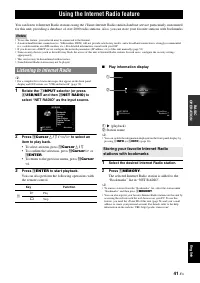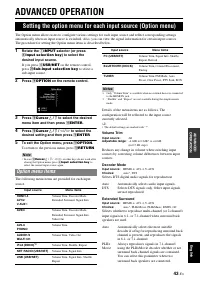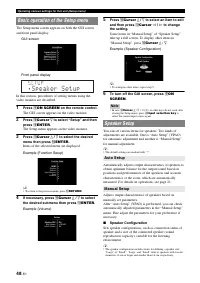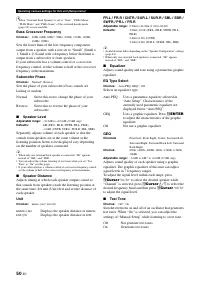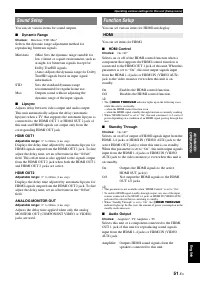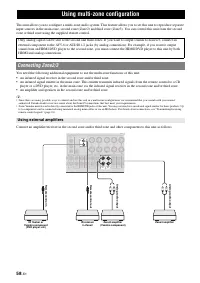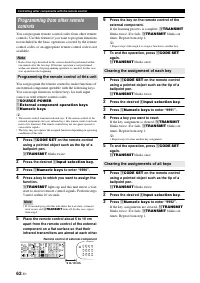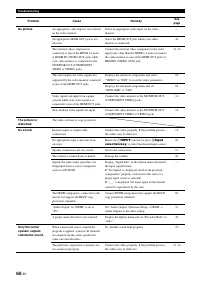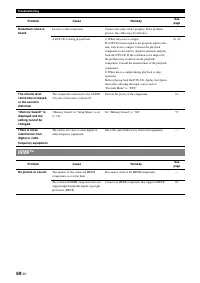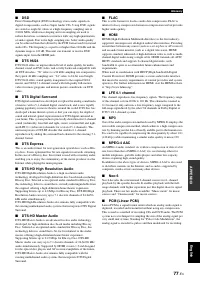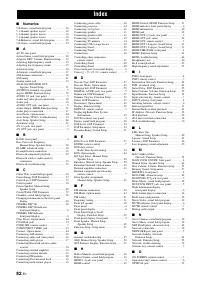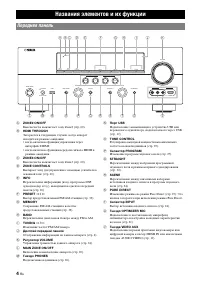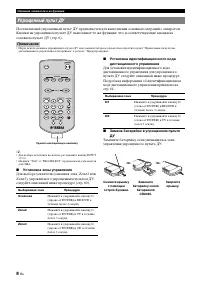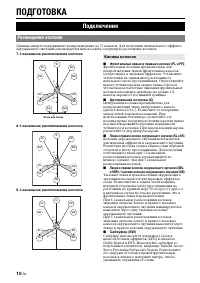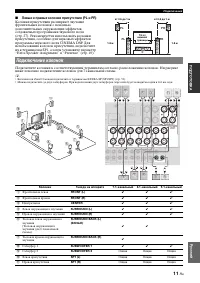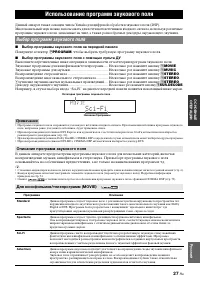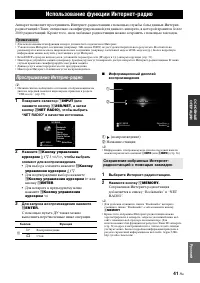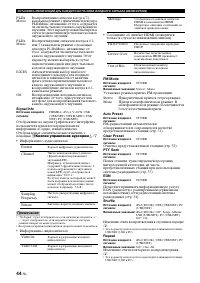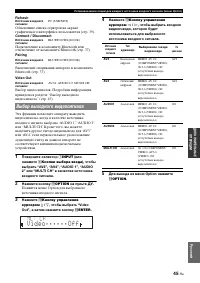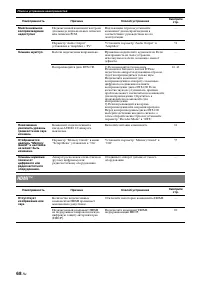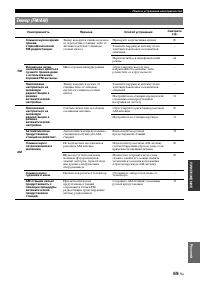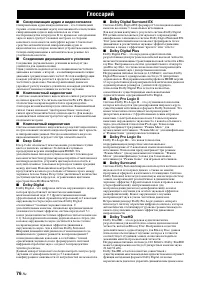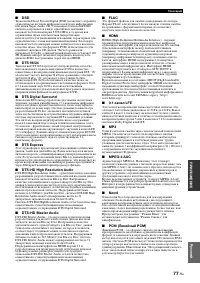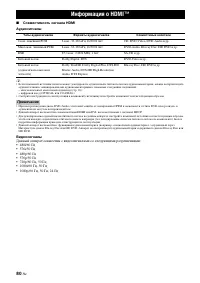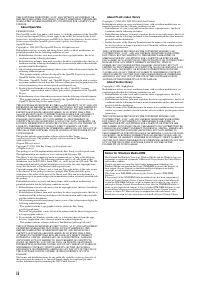Усилители Yamaha RX-V2065 - инструкция пользователя по применению, эксплуатации и установке на русском языке. Мы надеемся, она поможет вам решить возникшие у вас вопросы при эксплуатации техники.
Если остались вопросы, задайте их в комментариях после инструкции.
"Загружаем инструкцию", означает, что нужно подождать пока файл загрузится и можно будет его читать онлайн. Некоторые инструкции очень большие и время их появления зависит от вашей скорости интернета.

77
En
Glossary
English
INTR
ODUCTION
APPENDIX
PRE
PARA
T
ION
BA
S
IC
OPERA
T
ION
AD
VANCED
OPERA
T
ION
■
DSD
Direct Stream Digital (DSD) technology stores audio signals on
digital storage media, such as Super Audio CDs. Using DSD, signals
are stored as single bit values at a high-frequency sampling rate of
2.8224 MHz, while noise shaping and oversampling are used to
reduce distortion, a common occurrence with very high quantization
of audio signals. Due to the high sampling rate, better audio quality
can be achieved than that offered by the PCM format used for normal
audio CDs. The frequency is equal to or higher than 100 kHz and the
dynamic range is 120 dB. This unit can transmit or receive DSD
signals input from the HDMI jack.
■
DTS 96/24
DTS 96/24 offers an unprecedented level of audio quality for multi-
channel sound on DVD video, and is fully backward-compatible with
all DTS decoders. “96” refers to a 96 kHz sampling rate compared to
the typical 48 kHz sampling rate. “24” refers to 24-bit word length.
DTS 96/24 offers sound quality transparent to the original 96/24
master, and 96/24 5.1-channel sound with full-quality full-motion
video for music programs and motion picture soundtracks on DVD
video.
■
DTS Digital Surround
DTS digital surround was developed to replace the analog soundtracks
of movies with a 5.1-channel digital sound track, and is now rapidly
gaining popularity in movie theaters around the world. DTS, Inc. has
developed a home theater system so that you can enjoy the depth of
sound and natural spatial representation of DTS digital surround in
your home. This system produces practically distortion-free 6-channel
sound (technically, front left and right, center, surround left and right,
and LFE 0.1 (subwoofer) channels for a total of 5.1 channels). This
unit incorporates a DTS-ES decoder that enables 6.1-channel
reproduction by adding the surround back channel to the existing 5.1-
channel format.
■
DTS Express
This is an audio format for next-generation optical discs such as Blu-
ray discs. It uses optimized low bit rate signals for network streaming.
In the case of a Blu-ray disc, this format is used with secondary audio,
enabling you to enjoy the commentary of the movie producer via the
Internet while playing the main program.
■
DTS-HD High Resolution Audio
DTS-HD High Resolution Audio is a high resolution audio
technology developed for high-definition disc-based media including
Blu-ray Disc. Selected as an optional audio standard for Blu-ray Disc,
this technology delivers sound that is virtually indistinguishable from
the original, offering a high-definition home theater experience.
Supporting bitrates up to 6.0 Mbps for Blu-ray Disc, DTS-HD High
Resolution Audio can carry up to 7.1 discrete channels of 24-bit/96
kHz audio simultaneously.
DTS-HD High Resolution Audio also remains fully compatible with
the existing multichannel audio systems that incorporate DTS Digital
Surround.
■
DTS-HD Master Audio
DTS-HD Master Audio is an advanced lossless audio technology
developed for high-definition disc-based media including Blu-ray
Disc. Selected as an optional audio standard for Blu-ray Disc, this
technology delivers sound that is bit-for-bit identical to the studio
master, offering a high-definition home theater experience.
Supporting bitrates up to 24.5 Mbps for Blu-ray Disc, DTS-HD
Master Audio can carry up to 7.1 discrete channels of 24-bit/96 kHz
audio simultaneously. Supported by HDMI version 1.3 and designed
for the optical disc players and AV receivers/amplifiers of the future,
DTS-HD Master Audio also remains fully compatible with the
existing multichannel audio systems that incorporate DTS Digital
Surround.
■
FLAC
This is a file format for lossless audio data compression. FLAC is
inferior to lossy compression formats in compression rate but provides
higher audio quality.
■
HDMI
HDMI (High-Definition Multimedia Interface) is the first industry-
supported, uncompressed, all-digital audio/video interface. Providing
an interface between any source (such as a set-top box or AV receiver)
and an audio/video monitor (such as a digital television), HDMI
supports standard, enhanced or high-definition video as well as multi-
channel digital audio using a single cable. HDMI transmits all ATSC
HDTV standards and supports 8-channel digital audio, with
bandwidth to spare to accommodate future enhancements and
requirements.
When used in combination with HDCP (High-bandwidth Digital
Content Protection), HDMI provides a secure audio/video interface
that meets the security requirements of content providers and system
operators. For further information on HDMI, visit the HDMI website
at “http://www.hdmi.org/”.
■
LFE 0.1 channel
This channel reproduces low-frequency signals. The frequency range
of this channel is from 20 Hz to 120 Hz. This channel is counted as
0.1 because it only enforces a low-frequency range compared to the
full-range reproduced by the other 5/6 channels in Dolby Digital or
DTS 5.1/6.1-channel systems.
■
MP3
One of the audio compression methods used by MPEG. It employs the
irreversible compression method, which achieves a high compression
rate by thinning out the data of hardly audible part to the human ears.
It is said to be capable of compressing the data quantity by about 1/11
(128 kbps) while maintaining a similar audio quality to music CD.
■
MPEG-4 AAC
An MPEG-4 audio standard. As it allows compression of data at a bit
rate lower than that of MPEG-2 AAC, it is used among others for
mobile telephones, portable audio players and other low-capacity
devices requiring high sound quality.
In addition to the above types of devices, MPEG-4 AAC is also used
to distribute contents on the Internet, and as such is supported by
computers, media servers and many other devices.
■
Neo:6
Neo:6 decodes the conventional 2-channel sources for 6- channel
playback by the specific decoder. It enables playback with the full-
range channels with higher separation just like digital discrete signal
playback. There are two modes available: “Music mode” for music
sources and “Cinema mode” for movie sources.
■
PCM (Linear PCM)
Linear PCM is a signal format under which an analog audio signal is
digitized, recorded and transmitted without using any compression.
This is used as a method of recording CDs and DVD audio. The PCM
system uses a technique for sampling the size of the analog signal per
very small unit of time. Standing for “Pulse Code Modulation”, the
analog signal is encoded as pulses and then modulated for recording.
Содержание
- 87 ВВЕДЕ; СОДЕРЖАНИЕ; ВВЕДЕНИЕ
- 88 Описание
- 89 АЯ; Bluetooth; Убедитесь в наличии всех перечисленных ниже деталей.; О данном руководстве; Поставляемые принадлежности
- 90 Названия элементов и их функции; Передняя панель
- 91 Задняя панель
- 92 Примечание; Установка батареек; Снимите крышку отделения для батареек.; Зона действия; Дисплей передней панели; Пульт ДУ
- 94 Установка зоны управления; Упрощенный пульт ДУ
- 95 Краткое руководство пользователя; Шаг 1: Подготовьте компоненты к
- 96 ПОДГОТОВКА; Фронтальные левые и правые колонки (FL и FR); Подключения; Размещение колонок; Каналы колонок
- 97 Подключение колонок
- 98 Подключение кабелей колонок; Предупреждение
- 99 Информация о гнездах и штекерах кабелей
- 100 Подключение ТВ-экрана или проектора
- 101 Вывод звука телевизора через аппарат
- 102 Подключение других компонентов
- 103 Поток аудиосигналов; Примечания; Информация о выходных аудио/видеогнездах
- 104 Подключение внешнего усилителя; Передача/прием сигналов дистанционного управления
- 105 Подключение к сети; Использование гнезд VIDEO AUX
- 106 Подключение силового кабеля
- 107 ДОПОЛНИТЕЛЬН; наушники отсоединены от аппарата; Оптимизация настройки колонок для комнаты для; Использование Auto Setup
- 109 Повтор процедуры “Auto Setup”.
- 110 ОСНОВНЫЕ ОПЕРАЦИИ; Воспроизведение; Основная процедура; Использование функции SCENE; Выбор SCENE
- 111 Приглушение выводимого звука
- 112 Вставьте наушники в гнездо; на; Несколько раз нажмите кнопку; Использование наушников
- 113 Поверните селектор; Выбор программы звукового поля с помощью пульта ДУ; Использование программ звукового поля; Выбор программ звукового поля; Описание программ звукового поля
- 115 Для воспроизведения многоканального стереозвука (STEREO)
- 117 Настройка радиопрограмм диапазона FM/AM
- 118 Удаление предустановленных радиостанций
- 119 Настройка на систему радиоданных; Наименование программы, частота
- 121 Использование iPodTM; Управление iPodTM
- 123 Использование компонентов BluetoothTM
- 124 Использование запоминающих устройств USB
- 125 Использование компьютерных серверов
- 127 Использование функции Интернет-радио; Прослушивание Интерне-радио
- 128 чтобы установить временной промежуток.; Другие функции; Выбор гнезда HDMI OUT; Использование таймера сна
- 129 ДОПОЛНИТЕЛЬНЫЕ ОПЕРАЦИИ; Пункты меню Option
- 130 Кнопки управления курсором
- 131 Обновление списка серверов на экране; Выбор выходного видеосигнала
- 132 Управление различными настройками аппарата (меню Setup)
- 134 Экран графического интерфейса пользователя; Основные операции меню Setup
- 136 Кнопку управления
- 138 Volume
- 140 Основные параметры CINEMA DSP
- 142 Reverb Time
- 143 Параметры декодера
- 144 Приемник инфракрасных сигналов во второй и/или третьей зоне.; Использование многозонной конфигурации; Использование внешних усилителей
- 145 Использование внутренних усилителей аппарата; Важное предупреждение о безопасности
- 146 выбор источника входного сигнала; Если была нажата кнопка; Операции в режиме управления Zone2/3
- 147 Управление другими компонентами с помощью пульта ДУ; Установка кодов ДУ
- 148 Программирование с других пультов ДУ
- 149 Дополнительные настройки
- 150 Нажмите кнопку; Установка идентификатора пульта ДУ
- 151 ÏÎÄÃÎÒÎÂÊÀ; ПРИЛОЖЕНИЕ; Поиск и устранение неисправностей; Неисправности общего характера
- 158 USB и сеть
- 160 Перед выполнением процедуры Auto Setup
- 161 После Auto Setup
- 162 Глоссарий
- 164 Частота выборки и глубина квантования
- 165 Информация о программах звукового поля
- 166 Совместимость сигнала HDMI; Видеосигналы; Информация о HDMITM
- 167 Технические характеристики
- 168 Индекс
- 169 PRE










































